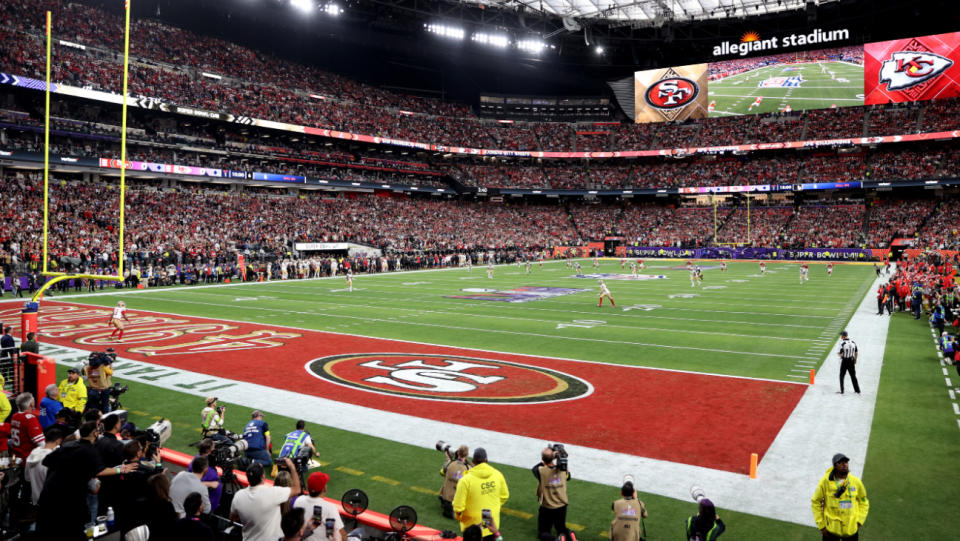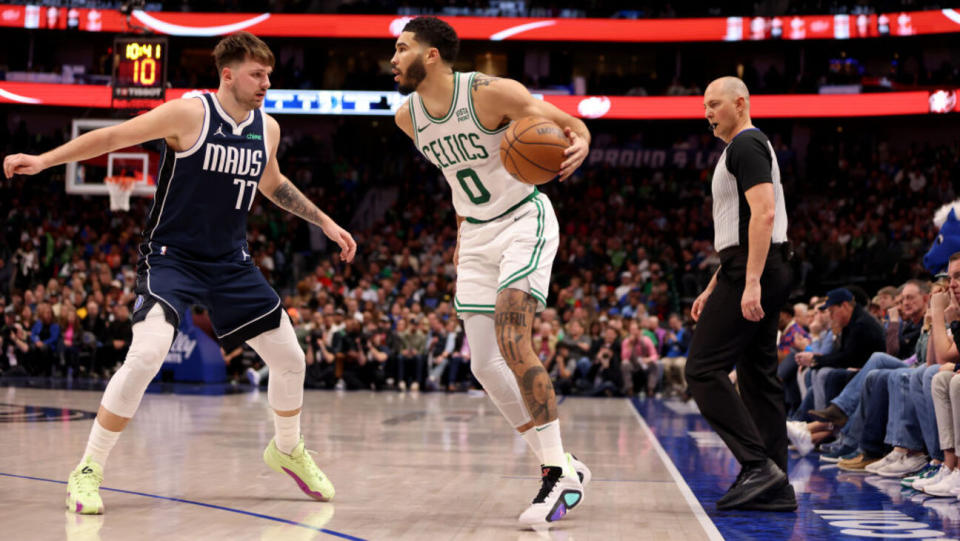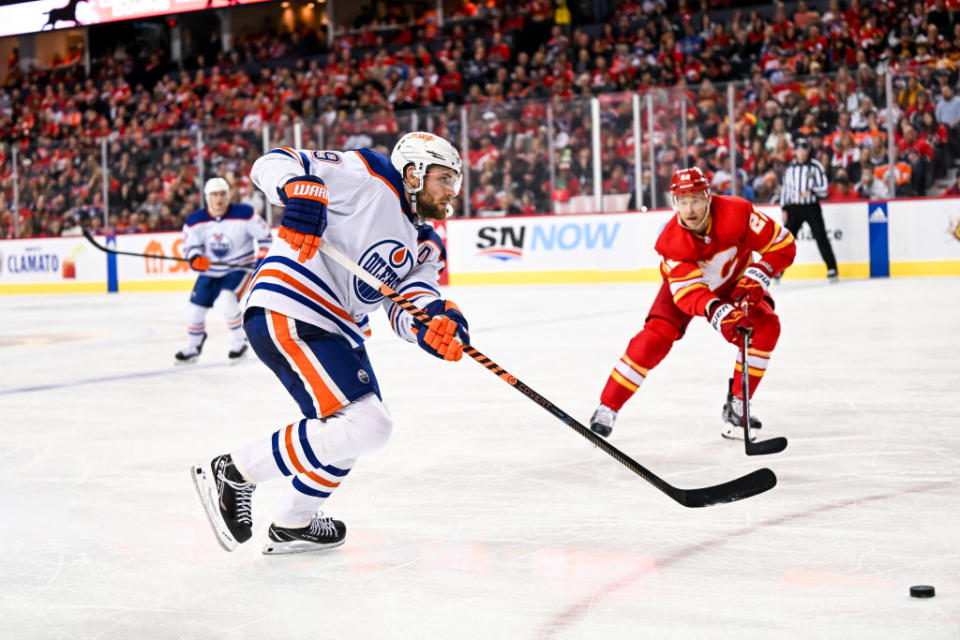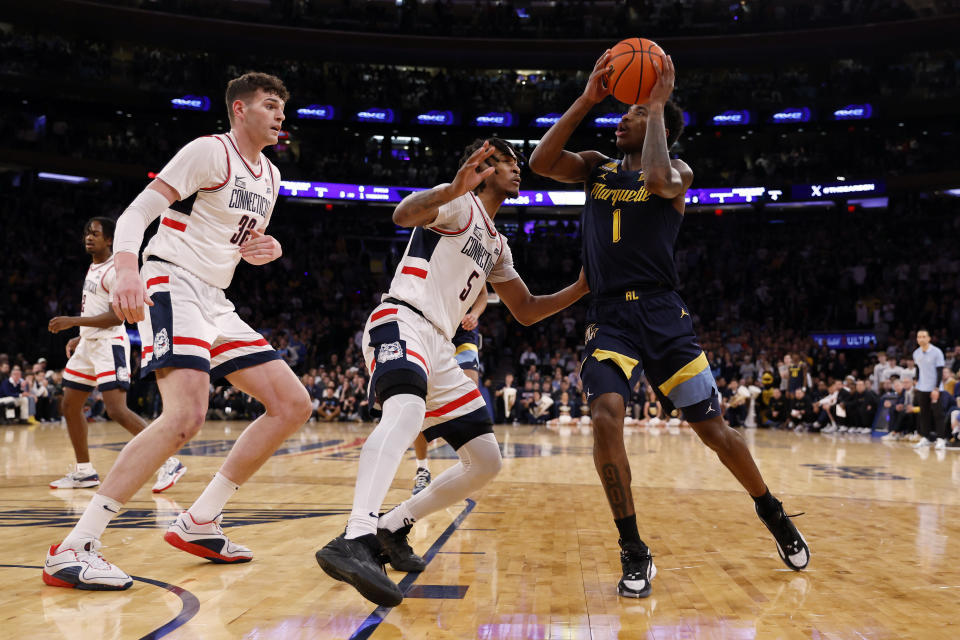Sports TV’s Multibillion-Dollar Rights Race: Where the Leaderboard Stands Right Now

Sometime in the near future, the NBA will sign a new TV contract that will roughly triple the value of its current deal. The league is likely to get a $70 billion-plus windfall (from ESPN and, most likely, NBC Sports and Amazon) — even though the audience for professional basketball has been mostly static in the past few years, and well below its pre-pandemic state.
Other sports have had similar ratings patterns in recent years (with the NFL being a planet-sized outlier). The catch is, live sports rank as maybe the single safest bet to bring a consistent audience to traditional TV, as well as an increasingly large carrot to dangle in front of streaming subscribers.
More from The Hollywood Reporter
Streaming Profits Are Tough to Find. Niche Movie and TV Platforms See a Way Forward
Shari Redstone Goes for Broke: Can Paramount Pick Up the Pieces?
It’s a paradox of the current TV business: The on-air audience for most sports (the NFL being a major exception) has shrunk along with the rest of traditional TV: Championships in baseball, hockey and college basketball, and NASCAR’s premier event, the Daytona 500, have all recorded some of their smallest audiences ever in recent years. But networks are paying ever larger sums for the rights to air and stream those games.
The NBA is the only major U.S. sports property with a new contract on the horizon; most others are locked in for at least a couple more years. But the league’s huge expected payday could set a precedent for the next rounds of negotiations (or send media giants, who are in cost-cutting mode, running the other way). Below, The Hollywood Reporter takes a closer look at the state of the sports TV landscape.
NFL

Current rights holders: Amazon, CBS, ESPN, Fox, NBC, NFL Network, Netflix, YouTube
Terms: Combined $100 billion over 11 years (through 2033) for the primary broadcast deal split among Amazon, CBS, ESPN, Fox, NBC and NFL Network. Netflix paid about $400 million for three years’ worth of exclusive Christmas Day games, and YouTube pays the league $2 billion per season for Sunday Ticket.
The bottom line: Unsurprisingly, the biggest thing on TV commands the biggest price tag from its media partners. The 4:25 p.m. ET Sunday game during the season (shared by CBS and Fox) is the most watched weekly broadcast on all of TV, and NBC’s Sunday Night Football is on a multi-year streak as the biggest primetime show on broadcast TV. Ratings for Amazon’s Thursday streaming package (which includes over-the-air broadcasts in teams’ home markets) grew by more than 20 percent last year. In short, it’s good — for both the NFL and its media partners — to be No. 1.
One possible wrench in the works: A recent court verdict ordered the league to pay $4.7 billion in an antitrust case that alleged the NFL artificially inflated the cost of Sunday Ticket and forced out-of-market fans to watch their team on the paid option rather than a free broadcast. The NFL is appealing the ruling, which could potentially upset its long-standing broadcast model. But for the near term, its sports TV supremacy is unquestionable.
NBA

Current rights holders: ESPN, TNT Sports, NBA TV
Terms: $24 billion for a nine-year deal that ends in 2025.
The bottom line: As mentioned above, the NBA is the only major media rights package currently in play after NASCAR locked down its next TV contract. While its ratings figures, like those of all other sports, pale in comparison to those of the NFL, the expected huge jump for the next contract has as much to do with volume as anything: More than 200 games (regular season and playoffs) in 2023-24 drew better than 1 million viewers, per Sports Media Watch. The vast majority of those ran on cable networks ESPN and TNT, and on cable 1 million is still a pretty solid number. A good portion of those games will likely transfer to streaming in a new deal, as both Amazon and NBC Sports — considered front-runners to join ESPN in the next deal — make sports a centerpiece of their respective streaming platforms (Prime Video and Peacock) and ESPN has both the joint venture Venu (with Fox and Warner Bros. Discovery) and its own stand-alone platform coming online in the next two years.
Also: The WNBA is part of the current NBA negotiations, and its current $60 million per season deal (with Amazon, CBS, ESPN and Scripps Sports) is likely to get a sizable bump as well following an influx of new viewers this season. It’s unclear who will operate the league-owned NBA TV if TNT, which currently does so, misses out on the next deal.
MLB

Current rights holders: Apple, ESPN, Fox, MLB Network, TNT Sports, Roku
Terms: ESPN, Fox and TNT are paying a combined $12 billion over seven years, ending in 2028. Apple has a separate seven-year deal, running through 2029 and worth a total of $595 million. Roku’s newly inaugurated Sunday afternoon games are worth $10 million per season to MLB.
The bottom line: The current baseball deal is nearing its midpoint, with Fox Sports, ESPN and TNT Sports sharing the bulk of nationally televised regular-season games and the playoffs; Fox remains the sole home of the World Series, which like most other championships has seen its audience decline in recent years (four of the five least-watched World Series on record have happened since 2020).
As with the NBA, though, the sheer number of those games — 108 among the three during the regular season — do a lot of heavy lifting in terms of both filling out a schedule and drawing decent-sized viewership in the summer and early fall.
Moreso than other major sports, however, baseball’s TV fortunes are tied up with regional sports networks — which are in rough shape. Rights for local market games may end up reverting to individual clubs, who could strike a deal with over-the-air affiliates or build their own direct-to-consumer models. MLB has also entered the streaming era with a set of Friday-night games on Apple TV+ and, as of this season, some Sunday afternoon contests on free streamer The Roku Channel, which took over that part of the deal from NBCU’s Peacock.
NASCAR

Current rights holders: Fox and NBC through the current season, joined by Amazon and TNT Sports beginning in 2025.
Terms: The 2025-31 deal for all four companies totals $7.7 billion. The CW has rights to the second-tier Xfinity Series for about $800 million over the same term, plus some races this fall.
The bottom line: The biggest TV draw in auto racing in the U.S., NASCAR will see its per-year rights fee go up — to $1.1 billion annually from $820 million in the current agreement — while spreading out the inventory of its primary Cup Series Races. Fox and NBC will each have 14 races at the start and end of every season (vs. 19 each now), with the remaining 10 split evenly between Amazon, where they’ll stream on Prime Video, and TNT Sports — with streaming on Max’s B/R Sports add-on in addition to on-air telecasts.
Fox will make up for some of its lost NASCAR spots via a rights deal with IndyCar, which includes the Indianapolis 500, for the relatively slight sum of $25 million per year starting in 2025. ESPN holds the U.S. rights for Formula 1 through 2025, paying around $90 million annually for the privilege.
NHL

Current rights holders: ESPN, TNT Sports
Terms: About $4.4 billion for a seven-year deal running through the 2027-28 season.
The bottom line: The ESPN/TNT deal has generally been a good one for both sides — ratings for the regular season in 2023-24 were their highest in eight years, with national games averaging just above half a million viewers. The Stanley Cup playoffs also grew, although the finals on ABC were down a little from when the network had them in 2022 (the finals alternate between ABC/ESPN and TNT each year).
Olympics

Current rights holder: NBC
Terms: $7.7 billion for the six winter and summer Olympics from 2022-32.
The bottom line: After getting involved in something of a bidding war for its last Olympics contract, NBC Sports got its current deal done quietly and smoothly a decade ago. The contract works out a modest increase from the past one (about $1.3 billion per Olympiad, vs. $1.1 billion previously) and hits every part of NBCUniversal’s TV business — broadcast, cable and streaming.
With the 2024 games in Paris, NBC and cable networks USA, CNBC, E! and Golf Channel and will present live event coverage during daytime hours, alongside Spanish-language coverage on Telemundo and Universo. NBC will run an extended highlights-and-storytelling package in primetime aimed at viewers who didn’t watch during the day. Peacock will stream literally everything — including every medal event in all 32 sports — live and feature several recap and highlight shows, plus an AI-generated “Al Michaels” that can deliver personalized highlights to users.
Soccer

Current rights holders: Amazon, Apple, CBS, ESPN, Fox, NBC, Scripps, Telemundo, TNT Sports, Univision
Terms: It’s complicated; see below.
The bottom line: Soccer, with its many domestic leagues and international competitions, has the most complex web of rights deals in the U.S. Among the international competitions, Fox and Telemundo have the rights to the men’s and women’s World Cups, but only through the 2026 men’s tournament (to be hosted primarily by the United States). Fox also has rights to the European championship through 2028, while Univision has Spanish-language rights over the same term. The currently running Copa America on Fox Sports is the company’s last under its current deal. CBS Sports holds the UEFA Champions League rights through 2030, while TNT Sports airs U.S. national team contests (men’s and women’s) including World Cup qualifiers, friendlies and other tournaments where there aren’t overlapping rights agreements. All told, those packages are worth about $3 billion by the end of their respective contracts.
At the domestic club level, Apple paid $2.5 billion to stream every MLS match through 2032, while Fox Sports will air a relative handful of them on a much cheaper ($30 million annually) deal through 2026. The National Women’s Soccer League is in the first year of a four-year pact with Amazon, CBS, ESPN and Scripps (which owns the Ion network) that pays a total of $240 million — a massive increase over the previous agreement with CBS Sports, which totaled just $4.5 million over three years. NBC Sports is halfway through a six-year, $2.7 billion contract with the English Premier League (and coming off its best season to date in the ratings). ESPN also carries Spain’s La Liga, mostly on its ESPN+ streaming platform. Univision is the long-time home of Mexico’s Liga MX and the Mexican national team.
Golf

Current rights holders: CBS, ESPN, NBC/Golf Channel, The CW
Terms: CBS, ESPN and NBC have a nine-year, $6.3 billion TV contract for the PGA Tour that runs through 2030; those rights also include the LPGA Tour, though ESPN’s portion of the latter expires next year. The CW has a deal with the Saudi-backed LIV Golf through 2024, with an option for 2025.
The bottom line: The PGA and LPGA tours fill hundreds of hours of programming for their respective partners for 10 months of the year. CBS has the most final-round coverage on the men’s side, with at least 19 events per year, while NBC has at least eight per season. The NBC-owned Golf Channel carries every LPGA event (with some weekend coverage on NBC or CBS). ESPN has a somewhat smaller footprint, offering live coverage of most PGA events via ESPN+.
The three companies also have long-term rights to the four major men’s tournaments — The Masters, PGA Championship (both on CBS and ESPN), U.S. Open and British Open (both on NBC); the Masters doesn’t charge for TV rights, and terms for the others aren’t disclosed. LIV Golf and The CW reportedly have a revenue-sharing agreement that splits ad dollars for those events.
College Sports

Current rights holders: CBS, ESPN, Fox, NBC and TNT Sports primarily
Terms: The four power conferences have long-term agreements with CBS, ESPN, Fox and NBC totaling about $16 billion through 2030 and beyond. See below for championship tournament deals.
The bottom line: The influx of 10-figure TV deals has fundamentally reshaped the college sports landscape — it’s why UCLA and USC are now members of the Midwest-based Big Ten (whose biggest media deals are with Fox, CBS and NBC), and their former Pac-12 Conference foes Cal and Stanford are now part of the Atlantic Coast Conference (ESPN, plus a secondary deal with The CW). The SEC, now featuring not-very-southeastern schools Texas and Oklahoma, also has a huge long-term agreement with ESPN. TNT Sports has secured smaller contracts with the Big East and Mountain West conferences and sublicensed some CFP games from ESPN, which will help shore up its sports programming if (as seems likely) it no longer has the NBA in a year.
While regular-season programming of (mostly) football and basketball takes up the bulk of programming hours for the major rights holders, the postseason in those two sports draw the biggest audiences. ESPN has been the home of the College Football Playoff since its inception in the 2014-15 season and in March signed a six-year, $7.8 billion extension to keep it through 2031-32. CBS and TNT Sports have shared the men’s NCAA basketball tournament since 2011; an eight-year extension covering the 2025-32 editions of March Madness cost them $8.8 billion. ESPN paid $920 million for an eight-year deal covering all other NCAA Division I championships through 2031-32 (up from $500 million in the previous deal). About $520 million of that is for the women’s basketball tourney, which had a record-smashing year in 2024.
Best of The Hollywood Reporter

 Yahoo Movies
Yahoo Movies 
